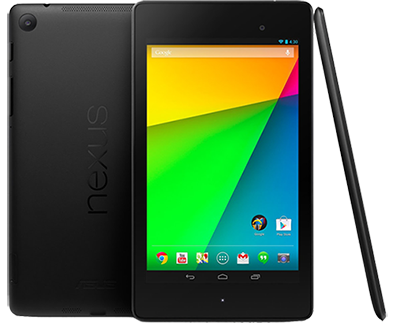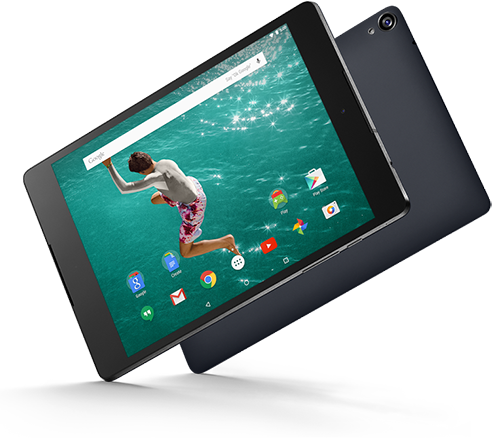Best Tablets: Holiday 2014
by Brandon Chester on November 28, 2014 8:00 AM ESTAndroid Tablets
The Android tablet space is more diverse than the selection of tablets running iOS due to the sheer number of manufacturers that make Android tablets. However, it seems like many of them in the low range make compromises that severely reduce their appeal, and other high end tablets like the Galaxy Tab S are let down by SoCs that struggle against A7, A8, Snapdragon 805, and Tegra K1. That being said, we've seen the launch of two new tablets this year from manufacturers that one might be surprised to see in the tablet market. There's also an old favorite that remains almost as compelling now as it did when it launched quite some time ago.
Our recommendation at the most affordable price point is the Nexus 7 (2013). The recommendation of a budget tablet from over one year ago may sound strange, but the Nexus 7 remains a very high quality and capable device for its price of $229. This returns to the point about other inexpensive Android tablets not being very compelling due to sacrifices in areas like the display or the build quality. It may be that other manufacturers have found it difficult to compete with Google who doesn't necessarily need to make profit off of the device itself if they believe they will get revenue from advertising and purchases on Google Play.
Whatever the case may be, the Nexus 7 still seems to be the best Android tablet available at this price point. Its 1920x1200 display is still best in class for 7" tablets, with accurate factory calibration and a maximum brightness that stands high above every other tablet. The build quality and battery life are also exceptional for its price, and although the APQ8064-1AA SoC has aged since it released, it's still a capable device that receives updates directly from Google. The biggest issue about the Nexus 7 is finding it, as Google has recently discontinued it and removed it from sale on Google Play. That being said, if you can find it at another online retailer or a nearby store, it's definitely worth considering.
Our next recommendation is the NVIDIA SHIELD Tablet which starts at $299 with an optional $59 controller. This recommendation is aimed at anyone who wants to use the Android OS and wants to be able to play games on their tablet. Although some may laugh at the idea of a tablet as a gaming device, when paired with its controller the SHIELD Tablet is actually a viable gaming device. NVIDIA has put a lot of effort into taking classic games like Half Life 2 and Portal that were once limited to gaming consoles and PCs and making them available on the SHIELD Tablet. Their new GRID game streaming service has also just begun its expansion, which will allow people to play various games streamed over a network connection.
For users who don't intend to play many games, the SHIELD Tablet is still worth considering. The Cortex-A15 based Tegra K1 is very competitive with the CPU performance of other Android tablets, and the GPU performance is rivaled only by Apple's A8X in the iPad Air 2. The battery life is also good at 10.83 hours, although it doesn't really stand out from other tablets. The display may also be an issue for some buyers, with similar panel characteristics as the iPad Mini. This puts it significantly behind the cheaper Nexus 7 for both display accuracy and brightness.
From a software support perspective, one might expect the SHIELD Tablet to be a worse option than the Nexus 7. However, NVIDIA has proven to be very quick in shipping updates, and the SHIELD Tablet has already been updated to the recently released Android Lollipop; that should put to rest any concerns about updates. Ultimately, for gamers who want Android, the SHIELD Tablet is the best choice. For those less interested in gaming, one will have to consider the $70 increase in price over the Nexus 7, and decide whether to prioritize performance or display quality.
Last, but not least, we have the newly released Nexus 9 that is made by HTC and starts at $399. This is the first Nexus device that Google has had HTC build since the Nexus One, and it's HTC's first tablet since they exited the market in 2012. In a way, the Nexus 9 can be called a successor to the Nexus 7, as its release coincided with the Nexus 7 being discontinued. That being said, the Nexus 9 is definitely not the budget tablet that the Nexus 7 was. At $399, it's well within the price territory of the iPad, and it's almost double the cost of the Nexus 7. Although there are other high end Android tablets at this price point, the Nexus 9 feels like the only Android tablet that actually justifies a premium price by competing with the silicon inside of Apple's iPad.
Inside the Nexus 9 is NVIDIA's Tegra K1 Denver, making it one of the first 64-bit Android devices. The display maintains the standards that Google set with the Nexus 7, with accurate color calibration and a high brightness, although its larger size prevents it from reaching the brightness of the Nexus 7. The tablet is primarily plastic, with a metal band around the edge. At $399 users may be hoping for a bit more in terms of materials, and reports of significant flex in the back cover don't help with giving it a premium feel.
Despite some concerns about the build, at $399 the Nexus 9 is really the obvious choice for anyone looking for a high end tablet running Android. We haven't seen any other Android tablets launch this year that compete with both its display and its speed. However, it may be a hard sell for anyone without any platform loyalty who is choosing between iOS and Android. The build quality and materials just aren't up to the standard of the iPad, and the 4:3 aspect ratio can cause scaled up applications to look worse than normal.
In the end this will again be up to the preference of the user. The iPad Air has more premium materials and a better feel, and perhaps a better selection of tablet software. However, it falls behind in its CPU and GPU performance, and the 1GB of RAM on a 64-bit iOS can be problematic. Despite some disappointments with the build, the Nexus 9 is still a very capable tablet, and it's the only Android tablet that manages to give high end hardware across the board.













87 Comments
View All Comments
Gich - Friday, November 28, 2014 - link
You can use legacy software on a convertible but on a tablet? you really can't use that old software with a touch interface, it is worst than terrible... so WinRT was actually fine for a tablet.Of course with the avaiability of Bay Trail WinRT got pointless...
redviper - Friday, November 28, 2014 - link
Well thats not true at all. You can use a lot of legacy software on x86 Windows tablets. Utilities that don't have the need for an interface, media players that are pretty touch friendly other than small close/maximize buttons, things like 7-zip which have large buttons. You can also install touchpointer and just have a normal pointer if you don't like touchy stuff.I use Qiqqa on my dell and it is a monster of an application for reference management, and I could do with 4 GB more ram, but even the pen works for highlighting and annotating. Don't underestimate the flexibility of windows.
przemo_li - Friday, November 28, 2014 - link
"Can use" and "Will use" are 2 different things.MS HAD TABLETS FOR MORE THEN 15 YEARS.
Yes those where "Classic" mode, bulky factor, but best of all they worked with "legacy" apps.
If such support was selling point we would see success long time ago.
"legacy" apps are bonus, not THE main selling point.
However for WinRT is was main WONT SELL point. As at that time MS marketed all tablets without "legacy" apps... as toys.
So WinRT is single OS harmed by lack of "legacy" apps.
Well done MS! ;)
hpglow - Friday, November 28, 2014 - link
This argument is irrelevant there are no Windows RT devices in this article. The Stream runs full 32 bit Windows. Also I would like to point out that for many tablet users who just browse the net and Facebook it would work just fine. The problem is that none of them were priced competitively enough for this use. Lack of x86 app support isn't the end all for many people. I use a Surface Pro 2 to write code sometimes and nothing compiles on it because MS jacked something up so given your argument regular Win 8.1 lacks backwards compatability as well (before someone says it yes the same code compiles with no error on my Win7 and Linux boxes). Also using caps to emphasize your points is obnoxious and unnecessary. Make an intelegent argument and you won't need caps.Samus - Friday, November 28, 2014 - link
The Stream is a truly unbeatable tablet for $99. It's hard to recommend anything else at that price point, Android or otherwise, simply based on software compatibility. It isn't like Google "apps" (Gmail, Talk, etc) don't run on Windows.Ananke - Monday, December 1, 2014 - link
Played with it yesterday in MS Store - it is worthless useless device. MS partners actually cut the RAM to 1GB on current tablets, and they are unusable today. I don't want to deep into arguments , but I pretty much followed my daily routine usage - the tablet always froze within couple minutes...24Gordon - Friday, December 5, 2014 - link
I was considering buying a Stream 7, but the 1GB was my main concern. Instead I opted to pay $50 more and get a Asus VivoTab 8 with 2GB of RAM. In my eyes, the Asus VivoTab 8 is a great deal at $149 on the Microsoft Store. I think it deserved a mention in this article, though I'm not sure it was out when it was written.Gich - Friday, November 28, 2014 - link
A program that needs little to no users inputs by definiton doesn't have much problems on how you interface with it...The example of media players works to a point: try the standard VLC and then an app... and not just to start/stop but also select subtitles, audio tracks and so on... this it's what i meant.
Of course you can tecnically use legacy software, and some might be usable... but well, on a tablet you should use something appropriate.
hughlle - Friday, November 28, 2014 - link
I won't deny that vlc on android is far superior to the desktop version, however on my surface pro 3 with its OTT resolution, desktop vlc is still perfectly usable with touch input, i don't have any issue with it and use it as my go to media software.Penti - Friday, November 28, 2014 - link
Media players in the store are terrible and Windows Runtime is not a good platform for it. Try VLC for Windows 8 and you'll see it's not worth the effort developing it for WinRT.It's simply Windows software btw, the alternative runtime isn't really a replacement or a good alternative outside phones. Windows Runtime can't run without Win32 and Win32 isn't going anywhere and isn't being deprecated. Stuff like VLC is two years in and the restrictions of Windows Runtime doesn't make much sense.